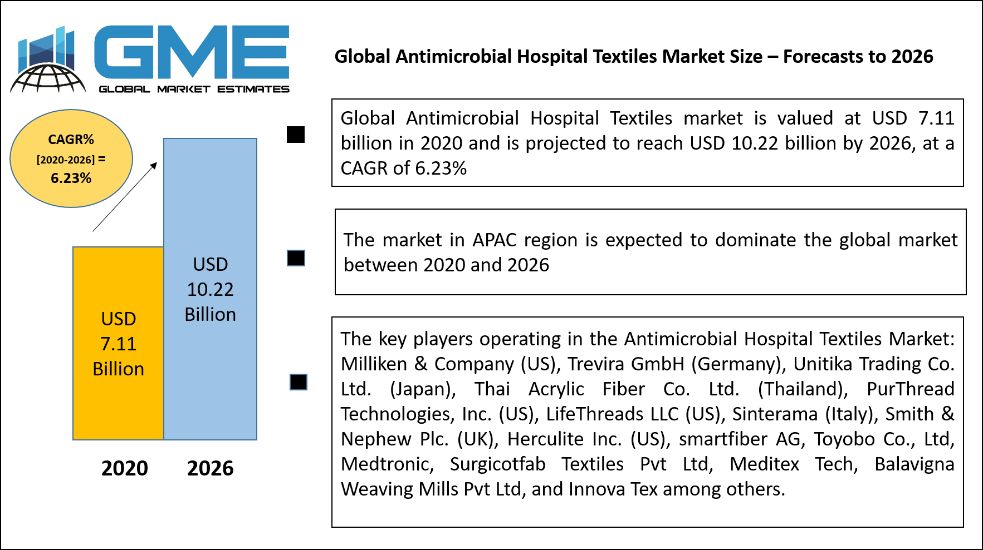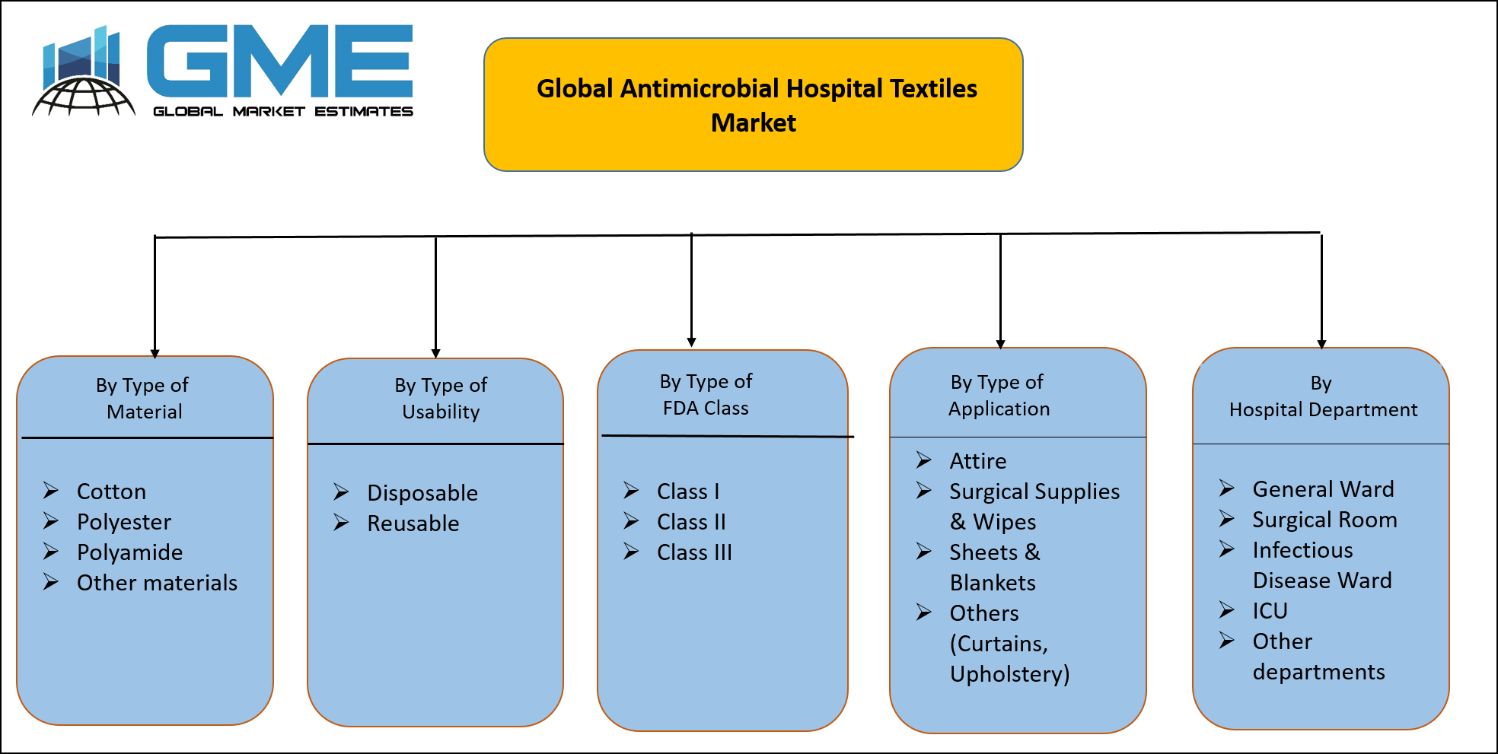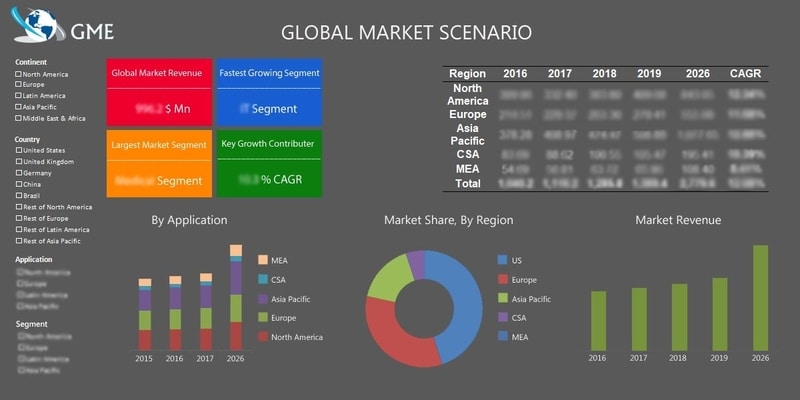
Global Antimicrobial Hospital Textiles Market Size, Trends & Analysis - Forecasts to 2026 By Type of Material (Cotton, Polyester, Polyamide, and Other materials); By Usability (Disposable, and Reusable); By FDA Class (Class I, Class II, and Class III); By Application (Attire, Surgical Supplies & Wipes, Sheets & Blankets, and Others [Curtains, Upholstery]); By Hospital Department (General Ward, Surgical Room, Infectious Disease Ward, ICU, and Other departments); By Region (North America, Europe, Asia Pacific, MEA, and CSA); End-User Landscape, Vendor Landscape, and Company Market Share Analysis & Competitor Analysis
Antimicrobial Hospital Textiles Market Insights
The global antimicrobial hospital textiles market will register a CAGR of 6.23% between the forecast period of 2020-2026. Antimicrobial hospital textiles have gained popularity in the past few years due to its potential ability to reduce infectious microbe transmission in the healthcare and medical domain. To fight with rapidly mutating microbes, the textile industry came up with an antimicrobial cloth solution, in which bactericidal composite is added during the cloth production. The antimicrobial properties of the fiber can improve the performance & shelf life of the products with a pleasant odor.
The increasing percentage of the geriatric population with the adoption of an advanced healthcare system and rising demand for healthcare products such as adult incontinence, baby diapers, tissues, and feminine products are the potential business booster of the antimicrobial textile market. Also, the government initiative to promote antimicrobial textiles is further adding values to the overall market growth.
Global pandemic created a huge business for antimicrobial hospital textile due to the massive demand for personal protective equipment in the forthcoming years. Raising awareness of hospital-acquired infections and changing lifestyles towards hygiene and healthcare is propelling the demand for the products in many regions of the globe.
However high cost and raw material availability is the major factor negatively affecting the antimicrobial market especially during a global pandemic when the demand for the product is high in comparison to normal days.

Antimicrobial Textiles Market: By Type of Material
Given by material used in the fibers, the market is segregated into Cotton, polyester, polyamide, and other materials. The cotton segment is expected to rule the global market. Cotton is extracted from the plant and is more susceptible to microbial attack. The soft and comforting properties of cotton are generating product demand in the medical and healthcare sectors hence significantly creating opportunities for building business in the coming years.
Antimicrobial Hospital Textiles Market: By Usability
Disposable, and Reusable are the sections based on the usability of antimicrobial hospital textiles. The disposable segment is dominated by the antimicrobial hospital textile market. The segment is designed to be cost-effective and one-time use to maintain the safety from infectious disease transmission and quality of protection in comparison to the reusable segment.
The extra cost for washing, bleaching, and conditioning can be neglected in disposable fabric with less risk of contamination from the previous patient.
Antimicrobial Hospital Textiles Market: By FDA Class
The FDA class of antimicrobial hospital textile market is bifurcated into class I, class II, and class III. FDA classified the antimicrobial textile market based on risk and regulatory control strategies to ensure the safety of the patient and medical staff from high disease risk.
Class III holds the command of the antimicrobial textile market in hospital sectors. Class III is a high-risk segment which protects from severe disease-causing pathogens during surgeries and fluid- intensive procedures. Class III includes gowns of high tensile strength, high breathability, and tear resistance. The increasing prevalence of severe disease coupling with high disease-causing population and research activities has escalated the overall product demand for the class III segment.
Antimicrobial Hospital Textiles Market: By Application
Given by type of application, antimicrobial hospital textile is explained into attire, surgical supplies & wipes, sheets & blankets, and other applications. Attire is the largest segment for the application market of antimicrobial hospital textiles. Doctors, staff members, and patients wear attire so as reduce the chances of disease caused by physical contact as patients having low immunity are potential for carrying and transmitting infections. Therefore to reduce hospital-acquired infection demand for antimicrobial attires is highest in hospitals.

Antimicrobial Hospital Textiles Market: By Hospital Department
Based on the hospital department the market is explained into the general ward, surgical room, infectious disease ward, ICU, and other departments. The general ward is the biggest segment dominating the market of antimicrobial hospital textiles. The general ward is a single common unite which is shared by all kinds of patients in the early phase of their disease diagnosis and therefore is more prone to infect patients having less immunity. Communicable diseases are most likely to spread at a higher rate in large immunocompromised patients. A global pandemic has uplifted the antimicrobial textile market immensely and is expected to build at a huge rate in forthcoming years.

Antimicrobial Hospital Textiles Market: By Region
Asia-Pacific is the largest and most prominent region for the antimicrobial hospital market. Increasing population, adoption of an effective and efficient healthcare system, and changing hospital regulatory norms towards the hygiene of patients and staff is boosting the demand for the product in the Asia-pacific region. In countries like China and India, there has been seen a large peak of chronic disease percentage in the last few years with an increase in hospital-acquired infection awareness which ends up generating demand for better linen clothing in the hospital sector.
North America dominated the 2019 antimicrobial hospital textile market and is expected to build the improved business in approaching years owing to the increasing count of surgeries & related healthcare workers. Increase the use of modified and innovative gowns by the hospital authority to diminish the transmission of hospital prone disorders is further expanded the product demand in the North American region
Antimicrobial Hospital Textiles Market Share and Competitor Analysis
The key players operating in the market include Milliken & Company, Innova Tex, Unitika Trading Co. Ltd., Balavigna Weaving Mills Pvt Ltd, Trevira GmbH, LifeThreads LLC, Sinterama, Meditex Tech, Herculite Inc, PurThread Technologies, Inc, Medtronic, Thai Acrylic Fiber Co. Ltd, Toyobo Co., Ltd, and Smith & Nephew Plc. among others.
Please note: This is not an exhaustive list of companies profiled in the report.
In July 2020, Milliken & Company (US) took a promising step towards the sustainable approach by increasing investment in Milliken Perimeter, an advanced reusable medical fabric. The company has already distributed around 10million yards of reusable medical fabric since March in response to global PPE storage.
In May 2019, Thai Acrylic Fiber Co. Ltd. (Thailand), launched a new product called Durashine fiber into the market. The product is used for outdoor fabric stitching and provides excellent resistance from ultraviolet rays.
Related Report: Global Conductive Textile Market Size, Trends & Analysis - Forecasts to 2026
Check the Press Release on Global Antimicrobial Hospital Textiles Market Report
We value your investment and offer free customization with every report to fulfil your exact research needs.
The Global Antimicrobial Hospital Textiles Market has been studied from the year 2017 till 2026. However, the CAGR provided in the report is from the year 2018 to 2026. The research methodology involved three stages: Desk research, Primary research, and Analysis & Output from the entire research process.

The desk research involved a robust background study which meant referring to paid and unpaid databases to understand the market dynamics; mapping contracts from press releases; identifying the key players in the market, studying their product portfolio, competition level, annual reports/SEC filings & investor presentations; and learning the demand and supply side analysis for the Antimicrobial Hospital Textiles Market.

The primary research activity included telephonic conversations with more than 50 tier 1 industry consultants, distributors, and end-use product manufacturers.

Finally, based on the above thorough research process, an in-depth analysis was carried out considering the following aspects: market attractiveness, current & future market trends, market share analysis, SWOT analysis of the companies and customer analytics.

Tailor made solutions just for you
80% of our clients seek made-to-order reports. How do you want us to tailor yours?
OUR CLIENTS